Rani Lakshmi Bai, also spelled as Laxmi Bai was born on November 19, 1835 in Kashi (Varanasi) in a Brahmin family of Moropant Tambe who was an employee of Peshwa Baji Rao II and she died on June 18, 1858, Kotah-ki-Serai, near Gwalior during her valour fight against British East India Company Raj. She was a Bharatiya queen of the Maratha princely state of Jhansi, currently situated in Jhansi district of Uttar Pradesh, Bharat. She was one of the leading figures of the Indian war of Independence 1857 and emerged as a symbol of resistance against the British Raj for Indian nationalists.
Rani Lakshmibai was born on November 19, 1828, in Varanasi to a Marathi Karhade Brahmin couple, Moropant Tambe and Bhagirathi Sapre. Named Manikarnika Tambe and nicknamed Manu, her mother died when she was four years old. Her father worked for Peshwa Baji Rao II of Bithoor district, who affectionately called her “Chhabili,” meaning “playful.” Educated at home, she was more independent than others her age and skilled in shooting, horsemanship, fencing, and mallakhamba, alongside her childhood friends Nana Sahib and Tatya Tope.
She married the Maharaja of Jhansi in 1842 and was rechristened Rani Lakshmibai in honor of Goddess Laxmi. After a fierce struggle against the British, she was killed on June 18, 1858. Her troops took her body away to fulfill her wish of not being captured by the British. Rani Lakshmibai became a leading figure in the 1857 War of Independence.
Rani Lakshmibai often rode on horseback, sometimes accompanied by a small escort or carried by palanquin. Her horses included Sarangi, Pavan, and Baadal. Archival evidence shows she rode Baadal when escaping from the fort in 1858. The Rani Mahal, her palace, is now a museum.
Battle at Jhansi and Final Sacrifice
The British forces arrived in Jhansi on March 21, 1858, and attacked. The Rani asked Tatya Tope for help, but his forces were defeated. Despite this, she supervised the defense. General Rose stormed the fort on April 3, 1858, and Jhansi fell under British control by April 5. Historian S.N. Sinha wrote that the Rani, dressed as a man, left the fort on the night of April 4 or the morning of April 5. She rode towards Kalpi, where the revolutionaries planned to resist British forces but failed. They then moved toward Gwalior, initially succeeding. On June 18, 1858, the British attacked again, forcing a retreat. The Rani was killed in this action. General Rose stated that she ordered a funeral pyre, which she lit herself. Another version suggests she chose death over life under British rule.
Twenty years later, Colonel Malleson wrote in “History of the Indian Mutiny” that despite her faults in British eyes, her countrymen would remember her as driven by ill-treatment into rebellion, living and dying for her country.
Lakshmibai’s bravery, courage, and fighting spirit are commemorated in numerous statues across India. Institutions named after her include Lakshmibai National University of Physical Education in Gwalior, Laksmibai National College of Physical Education in Thiruvananthapuram, and Maharani Laxmi Bai Medical College in Jhansi. Rani Lakshmi Bai Central Agricultural University in Jhansi was founded in 2013. The Rani Jhansi Marine National Park is in the Andaman and Nicobar Islands. A women’s unit of the Indian National Army was named the Rani of Jhansi Regiment. In 1957, two postage stamps commemorated the centenary of the rebellion. Indian representations in novels, poetry, and film often valorize Rani Lakshmibai’s devotion to the cause of Indian independence.



















Comments